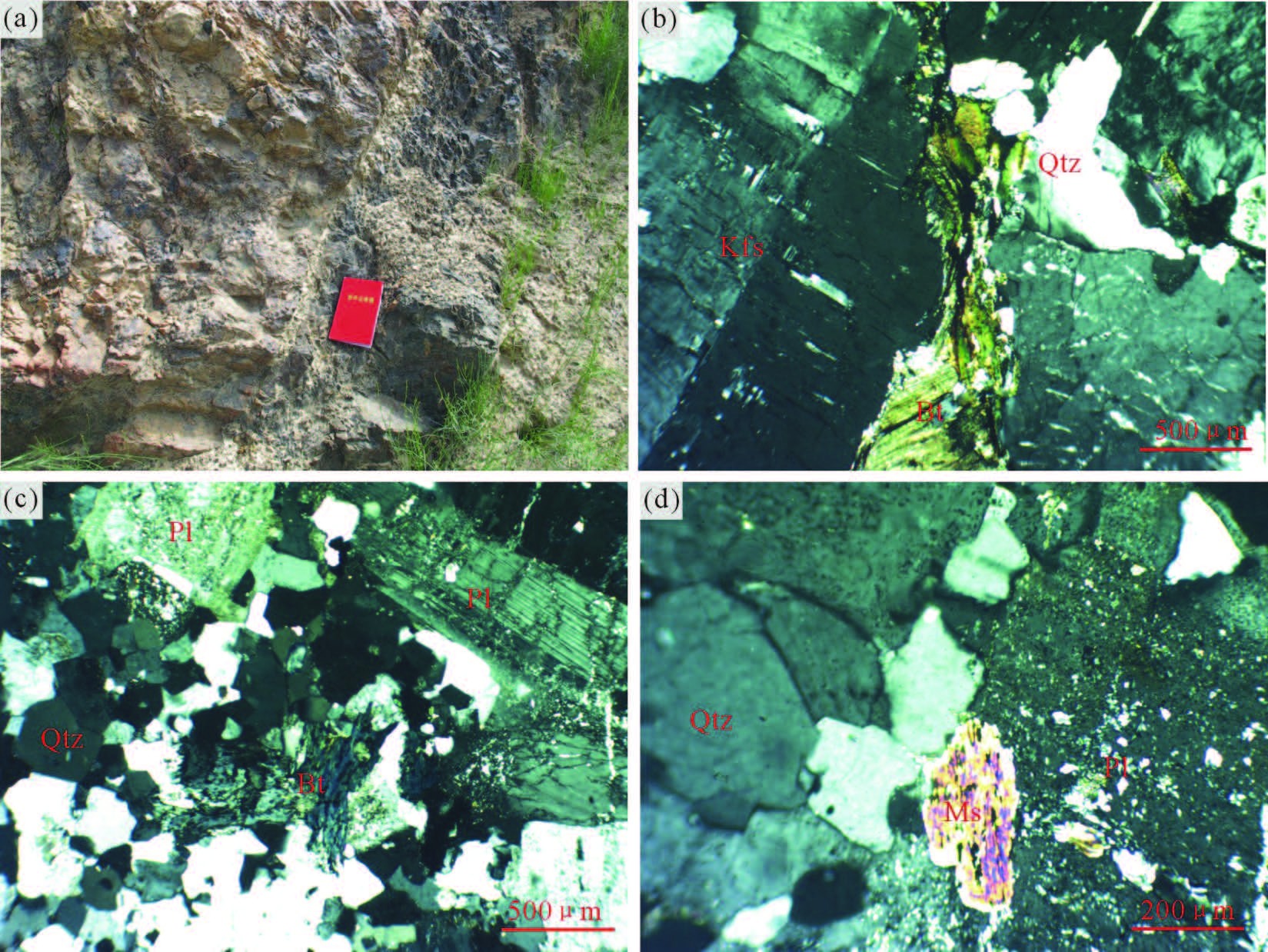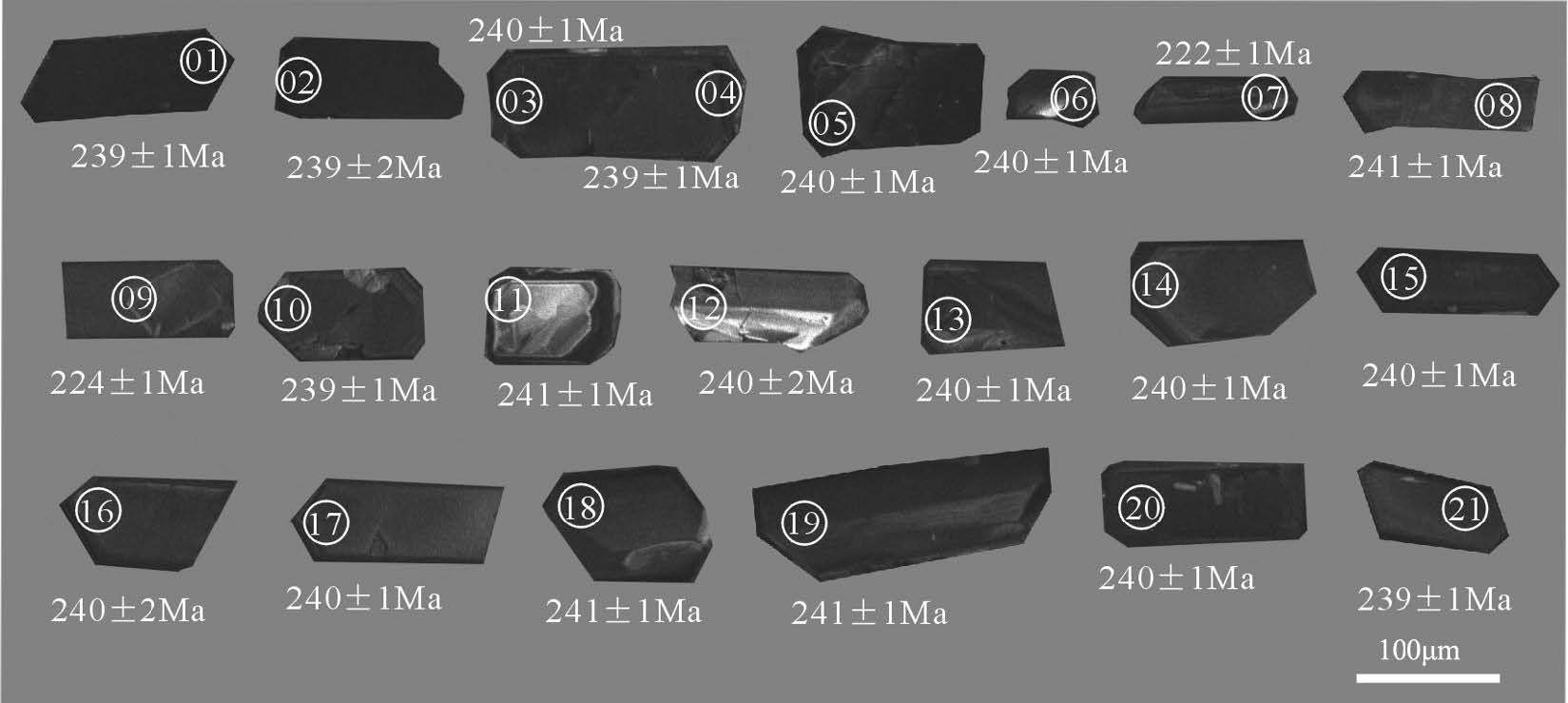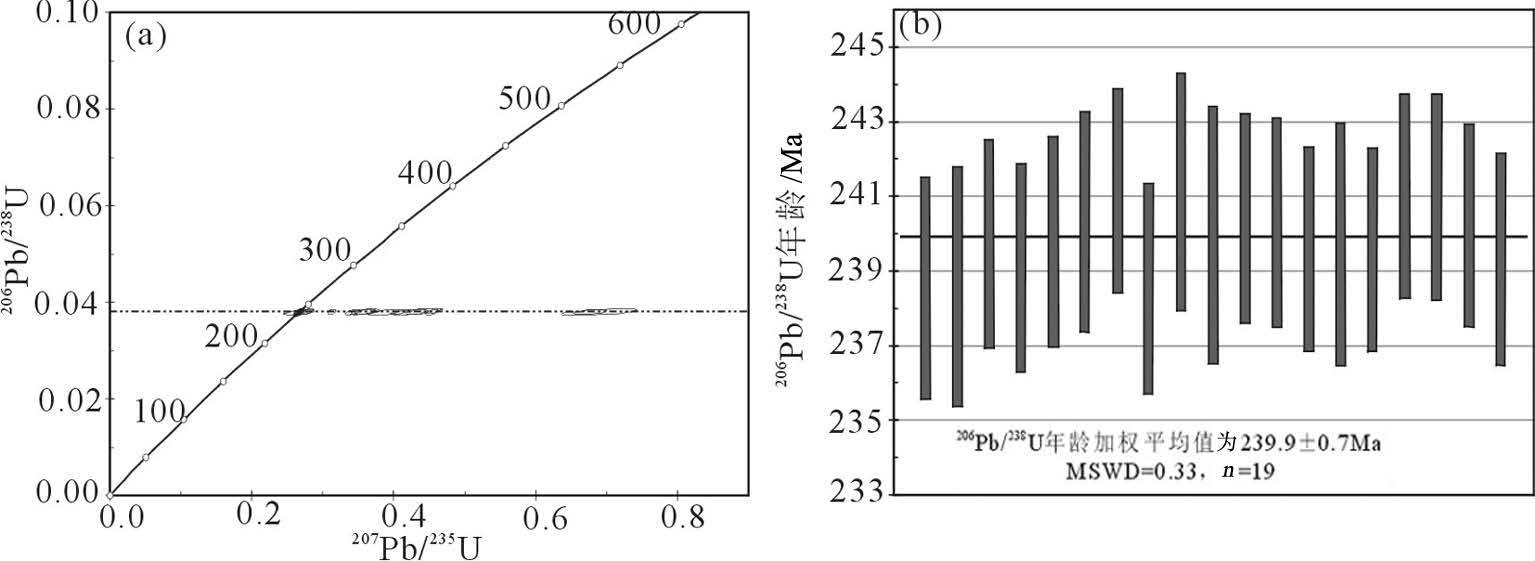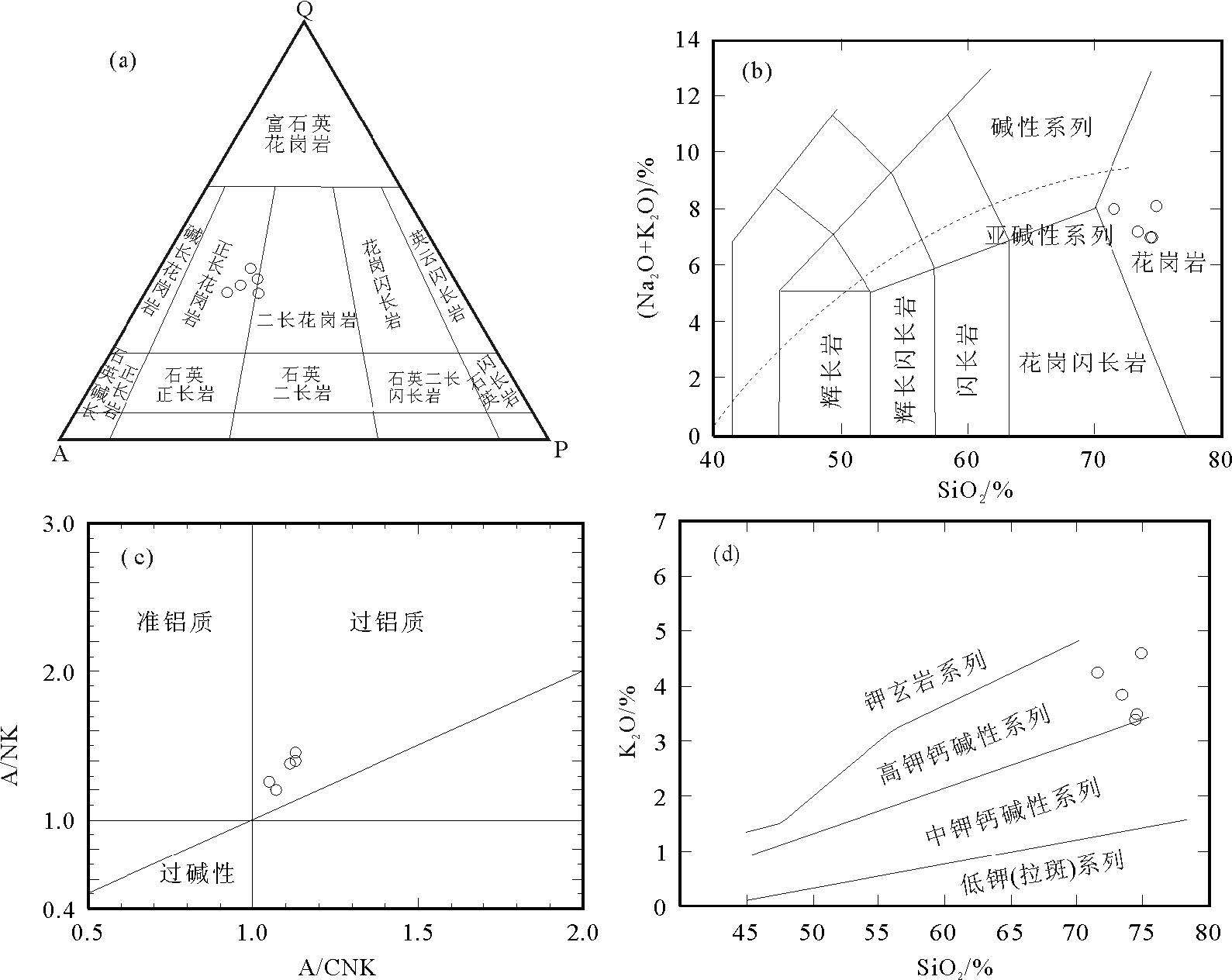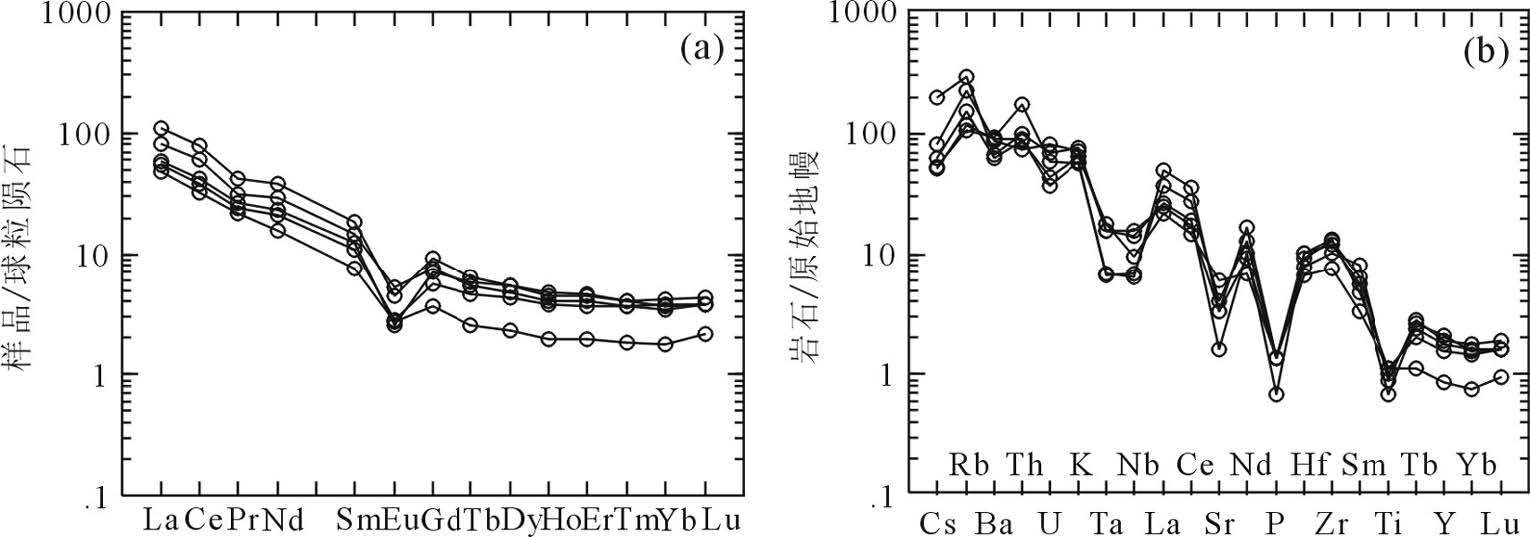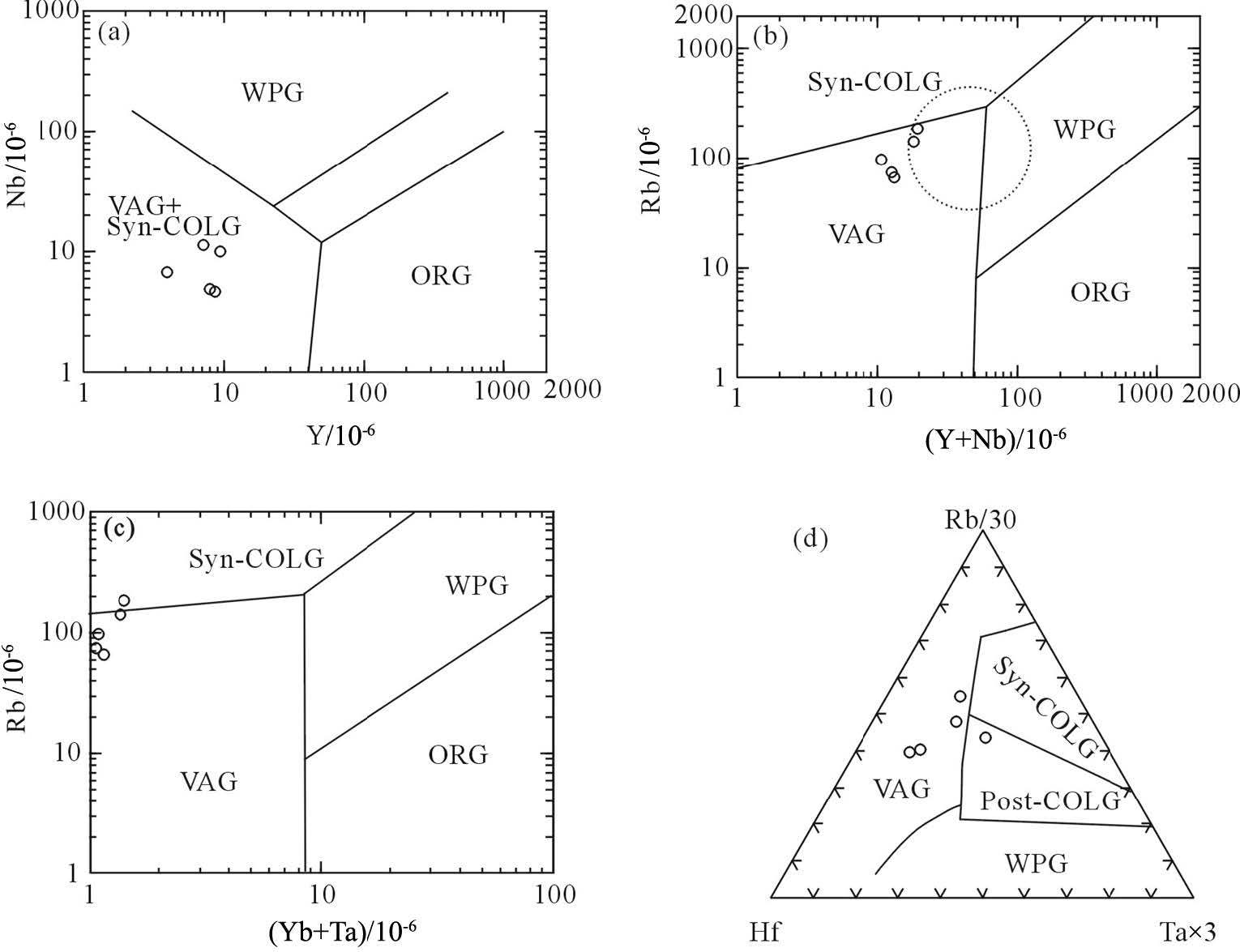LA-ICP-MS zircon U-Pb dating of the Chahantaolegai syenogranites in Xiangride area of East Kunlun and its geological significance
-
摘要:
东昆仑造山带东段察汗陶勒盖地区出露一套肉红色正长花岗岩,用LA-ICP-MS技术测得的锆石U-Pb年龄为239.9±0.7Ma,表明该岩体形成于中三叠世。地球化学特征表明,察汗陶勒盖正长花岗岩属于过铝质高钾钙碱性系列,岩石具有高SiO2、Al2O3、K2O和低TiO2、MnO、CaO的特征,A/CNK为1.05~1.13(平均值为1.10),K2O/Na2O值介于0.95~1.16之间,里特曼指数σ为1.56~2.24,CIPW标准矿物计算的刚玉质量分数大于1%,矿物组合中出现白云母等富铝矿物,显示S型花岗岩特征。稀土元素总量为61.47×10-6~145.23×10-6,球粒陨石标准化配分曲线显示,轻稀土元素富集((La/Yb)N=15.83~27.11),且有明显的负Eu异常(δEu=0.26~0.49)。原始地幔标准化蛛网图显示,岩石富集Rb、La、Th,亏损Ba、Ta、Sr、P、Ti等元素。微量和稀土元素特征显示出明显的壳源特征,其源岩可能为以上地壳杂砂质岩为主的沉积岩。结合区域资料认为,察汗陶勒盖正长花岗岩体具有过渡型花岗岩的特征,形成于俯冲向同碰撞转化阶段,是东昆仑南缘青山-阿尼玛卿洋壳俯冲晚期的产物。
-
关键词:
- 东昆仑东段 /
- 正长花岗岩 /
- 中三叠世 /
- LA-ICP-MS锆石U-Pb测年 /
- 俯冲造山
Abstract:A suite of syenogranites is exposed in the Chahantaolegai area along the eastern section of East Kunlun Orogenic Belt. LA-ICP-MS zircon U-Pb weighted average ages is 239.9±0.7Ma, suggesting the formation of syenogranites in Middle Triassic. According to the geochemical characteristics, it is suggested that Chahantaolegai syenogranites belong to peraluminous high-potassic calc-alkaline series. They are characterized by high SiO2, Al2O3, K2O and low TiO2 and Na2O values. A/CNK=1.05~1.13 (average A/CNK=1.10), K2O/Na2O ratios are about 0.95~1.16, and Rittmann index σ=1.56~2.24; the content of corundum exceeds 1%, as shown by CIPW standard mineral calculation. The existence of rock-forming minerals such as muscovite suggests that the syenogranites are of S-type. The values of rare earth elements are 61.47×10-6~145.23×10-6. The chondrite-normalized REE patterns of the samples show enrichment of LREE((La/Yb)N=15.83~27.11)and strong negative Eu anomalies(δEu=0.26~0.49). The primitive mantle-normalized trace element diagrams show enrichment of Rb, La and Th and depletion of Ba, Ta, Sr, P and Ti. Characteristics of trace and earth elements suggest that syenogranites were from the earth's crust. It is suggested that the syenogranites resulted from melting of the sedimentary rocks of the upper crust. Combined with regional studies, the authors hold that Chahantaolegai syenogranites are of the transitional type formed in the transformation from subduction to syn-collision, being a product of the late stage of the subduction of Buqinshan-A'nyemaqen Ocean on the southern margin of the East Kunlun in Middle Triassic.
-
东昆仑造山带位于青藏高原北部,柴达木盆地南缘,是中央造山系的重要组成部分。它是中国境内一条巨型岩浆岩带,具有特殊的大地构造意义[1-3]。位于东昆仑北部的东昆北构造带呈近东西向展布,最显著的特征是广泛发育花岗岩类。前人的大量研究资料[1, 4]多认为,东昆北构造带具有岩浆弧的特点,但对东昆北构造带中三叠世岩浆活动的研究仍相对薄弱。孙雨等[5]测得哈拉尕吐花岗岩的LAICP-MS 锆石U-Pb 年龄为256Ma;刘成东等[6]获得香日德南侧约格鲁地区花岗闪长岩体寄主岩的锆石U-Pb 年龄为242±6Ma,形成于中三叠世;谌宏伟等[7]、李碧乐等[8]通过对东昆仑造山带东段花岗岩体的研究获得锆石U-Pb 年龄为240Ma,认为东昆仑造山带在该时期进入洋壳俯冲作用的晚期;陈国超[9]认为,东昆仑造山带在237Ma 进入同碰撞阶段;熊富浩[10]对香日德东部地区正长花岗岩进行了锆石U-Pb 同位素测年,获得侵入年龄为236~238Ma,提出东昆仑古特提斯洋俯冲作用持续至中三叠世(约238Ma)。这些晚海西期—印支期花岗岩类的存在及组成对揭示东昆仑造山带的构造格局、形成演化等重大地质问题具有重要的科学意义。早—中三叠世是布青山-阿尼玛卿洋自南向北俯冲的主要时期[9-13],东昆仑造山带在该阶段的岩浆作用是探索其构造格局的重要证据,保存并记录了东昆仑造山带形成和演化的重要信息。
位于香日德东部地区的察汗陶勒盖正长花岗岩体,是东昆仑造山带中三叠世花岗岩体的一部分,通过详细的岩石学、年代学及地球化学研究,可对恢复重建东昆仑造山带东段晚古生代—早中生代构造格局的形成及东昆仑和巴颜喀拉地块的拼合过程进行约束。前人资料中,对本地区中三叠世岩浆活动的研究较少。鉴于此,本次选取东昆仑东段香日德东侧察汗陶勒盖正长花岗岩体,利用LAICP-MS 技术进行锆石U-Pb 同位素测定,并通过主量、微量元素研究,厘定该花岗岩体的形成时代和构造属性。
1. 区域地质概况及岩体地质
东昆仑造山带呈近东西向展布于青藏高原东北部,南邻巴颜喀拉造山带,北邻柴达木盆地,西被阿尔金大型走滑断裂截断。东昆仑造山带经历了长期且复杂的演化过程,存在2 条蛇绿岩带,北为东昆中蛇绿混杂岩带,南为东昆南布青山-阿尼玛卿蛇绿混杂岩带。因此,对东昆仑地区构造单元的划分多以两大缝合线为界[14]。结合前人研究成果和现有资料,将东昆仑造山带自北向南划分为4 个构造单元:东昆北构造带(昆北地体)、东昆南构造带(昆南地体)、布青山-阿尼玛卿蛇绿混杂岩带和巴颜喀拉造山带(图 1)。东昆北构造带出露前寒武系变质基底,包括高角闪岩相变质的古元古界白沙河岩组(Pt1b)、以石英质岩石为主的中元古界小庙岩组(Pt2x)[15-16],区域上被牦牛山组伸展的磨拉石组角度不整合覆盖,另有少量泥盆纪和石炭纪海相碳酸盐岩和碎屑岩沉积岩系,主体由大面积的印支期花岗岩组成。昆南地块和昆北地块之间出露有东昆中蛇绿岩带,自西向东为乌妥、清水泉和塔妥蛇绿岩带,前人多认为该缝合带中的蛇绿混杂岩为多期次、多旋回裂解拼合作用的综合产物;东昆南构造带主要由不同期次的各类花岗岩组成,以大量发育前寒武系基底变质岩系为特征,基底岩系外围为早石炭世—中二叠世沉积建造;布青山-阿尼玛卿蛇绿混杂岩带处于东昆南构造带和巴颜喀拉造山带之间,以二叠系马尔争组复理石沉积为主,其间混有早古生代和晚古生代2 期蛇绿混杂岩,刘战庆等[17]获得了布青山地区蛇绿岩中辉长岩锆石U-Pb 年龄为333±3Ma,证明布青山在晚古生代存在古洋壳。巴颜喀拉造山带以广泛发育三叠系巴颜喀拉群浊积岩系为主要特征。
![]() 图 1 东昆仑造山带构造单元划分及香日德地区地质简图1—第四系;2—上三叠统鄂拉山组;3—中元古界小庙岩组;4—古元古界白沙河岩组;5—印支期正长花岗岩;6—印支期花岗闪长岩;7—晚海西期正长花岗岩;8—晚海西期似斑状二长花岗岩;9—晚海西期二长花岗岩;10—晚海西期花岗闪长岩;11—加里东期花岗闪长岩;12—断层;13—109 国道;14—河流;15—锆石U-Pb 年龄采样点Figure 1. Tectonic unit division and position of the study area in East Kunlun and geological sketch map of Xiangride area
图 1 东昆仑造山带构造单元划分及香日德地区地质简图1—第四系;2—上三叠统鄂拉山组;3—中元古界小庙岩组;4—古元古界白沙河岩组;5—印支期正长花岗岩;6—印支期花岗闪长岩;7—晚海西期正长花岗岩;8—晚海西期似斑状二长花岗岩;9—晚海西期二长花岗岩;10—晚海西期花岗闪长岩;11—加里东期花岗闪长岩;12—断层;13—109 国道;14—河流;15—锆石U-Pb 年龄采样点Figure 1. Tectonic unit division and position of the study area in East Kunlun and geological sketch map of Xiangride area研究区位于东昆仑东段香日德镇东部察汗陶勒盖地区,大地构造位置属于东昆北构造带。研究区广泛出露晚海西期—印支期花岗岩类,与古元古界小庙岩组(Pt2x)呈侵入接触关系,部分地区出露晚三叠世鄂拉山组活动裂谷型陆相火山岩(T3e)[18]。
2. 岩石学特征
本次研究的东昆仑香日德地区察汗陶勒盖正长花岗岩为肉红色,具中粗粒花岗结构,块状构造(图 2-a),粒径3~6mm,主要矿物为钾长石(45%~50%),颗粒较大,多呈宽板状,卡式双晶发育(图 2-b);石英(30%~35%),呈他形粒状分布于其他矿物颗粒之间,具波状消光;斜长石较少(10% ~15%),表面略脏,可见绢云母化,聚片双晶发育,偶见卡纳复合双晶;黑云母含量较少(<10%),为片状矿物,具淡黄色-深褐色的多色性(图 2-b、c)。另外,镜下可观察到少量白云母(图 2-d),呈片状,在单偏光下呈无色透明。副矿物为少量的榍石、锆石等。野外未见包体。
3. 锆石U-Pb 年龄
3.1 测试方法
本次在香日德察汗陶勒盖地区采集1 件正长花岗岩样品进行锆石U-Pb 定年,样品采集位置地理坐标为N35°27′15″、E98°01′13″。样品分选在河北廊坊区域地质矿产调查研究所完成。将原岩粉碎至能通过200 目的筛网,淘洗并保留重砂,用电磁选、重液的方法将重砂中的锆石分选出来,在双目镜下挑选出锆石颗粒制成样品靶,对样品靶打磨和抛光,然后进行透射光、反射光和阴极发光照相。
锆石U-Pb 同位素分析在天津地质矿产研究所同位素实验室激光剥蚀电感耦合等离子质谱仪(LA-ICP-MS)上进行,仪器为配备有193nmA Rfexcimer激光器的Geo-Las200M 型(Microlas Gottin·gen Germany)激光剥蚀系统和Elan6100DRC 型四级杆质谱仪。分析采用激光剥蚀孔径为30μm,剥蚀深度为20~40μm,激光脉冲为10Hz,能量为32~36mJ。实验中用91500 作为外部锆石年龄标准进行同位素分馏校正,数据处理采用Isoplot(2.49 版)软件完成。采用208Pb 校正法对普通铅进行校正。利用NIST610 玻璃标样作为外标计算锆石样品的U、Th、Pb 含量。具体实验过程及试验方法详见参考文献[19-20]。
3.2 锆石特征及测试结果
本次测试的样品(2425/2)中锆石CL 图像如图 3所示。锆石为浅黄色-无色透明,晶形较完整,多呈柱状或锥柱状,少数不完整,粒度介于35~260μm之间,长宽比为1∶1~4∶1,锆石的阴极发光(CL)图像显示,锆石发育明暗相间的条带结构,属于典型的岩浆结晶产物[21-22]。锆石Th/U 平均值为0.46,也显示出岩浆结晶锆石的特征。锆石具有简单的内部结构,部分锆石表现出狭窄的浅色边,多为清晰的岩浆环带。
样品2425/2 共测试了21 个锆石颗粒(表 1),其中19 个测试点的206Pb/238U 年龄较为集中(图 4-a),给出的年龄加权平均值为239.9 ± 0.7Ma,MSWD=0.33(图 4-b),代表了察汗陶勒盖正长花岗岩的结晶年龄。其余2 个测试点(7、9)的206Pb/238U 年龄明显偏小,可能存在放射成因铅丢失,予以剔除。因此,本文将察汗陶勒盖正长花岗岩体的主体结晶年龄定为239.9±0.7Ma,属于中三叠世早期。
表 1 东昆仑香日德地区察汗陶勒盖正长花岗岩(2425/2)LA-ICP-MS 锆石 U-Th-Pb 同位素测试结果Table 1. LA-ICP-MS zircon U-Th-Pb isotopic data of the Chahantaolegai syenogranites(2425/2)in Xiangride, East Kunlun点号 元素含量/10-6 同位素比值 年龄/Ma Pb U Th 206Pb/238U 1σ 207Pb/235U 1σ 207Pb/206Pb 1σ 208Pb/232Th 1σ 232Th/238U 1σ 206Pb/238U 1σ 207Pb/235U 1σ 207Pb/206Pb 1σ 1 42 1122 419 0.0377 0.0002 0.2672 0.0036 0.0514 0.0008 0.0105 0.0001 0.3737 0.0009 239 1 240 3 259 36 2 37 955 439 0.0377 0.0003 0.2650 0.0022 0.0510 0.0004 0.0104 0.0001 0.4602 0.0062 239 2 239 2 240 19 3 37 935 951 0.0379 0.0002 0.3413 0.0042 0.0653 0.0008 0.0054 0.0001 1.0174 0.0056 240 1 298 4 785 26 4 30 744 445 0.0378 0.0002 0.2655 0.0019 0.0510 0.0004 0.0103 0.0001 0.5972 0.0048 239 1 239 2 239 16 5 45 1191 560 0.0379 0.0002 0.2668 0.0088 0.0511 0.0016 0.0089 0.0004 0.4699 0.0039 240 1 240 8 243 72 6 42 1041 436 0.0380 0.0002 0.3571 0.0070 0.0682 0.0012 0.0134 0.0002 0.4190 0.0019 240 1 310 6 874 38 7 19 526 176 0.0351 0.0002 0.2447 0.0017 0.0506 0.0004 0.0124 0.0010 0.3336 0.0043 222 1 222 2 222 16 8 25 642 296 0.0381 0.0002 0.2686 0.0019 0.0511 0.0004 0.0100 0.0001 0.4617 0.0012 241 1 242 2 246 16 9 57 1567 798 0.0354 0.0002 0.2464 0.0021 0.0504 0.0004 0.0099 0.0001 0.5092 0.0018 224 1 224 2 216 20 10 27 666 360 0.0377 0.0002 0.3581 0.0092 0.0689 0.0017 0.0104 0.0003 0.5403 0.0004 239 1 311 8 896 52 11 9 201 118 0.0381 0.0003 0.4426 0.0104 0.0842 0.0018 0.0159 0.0003 0.5873 0.0004 241 2 372 9 1298 41 12 15 313 206 0.0379 0.0003 0.6897 0.0218 0.1319 0.0033 0.0177 0.0005 0.6583 0.0010 240 2 533 17 2123 44 13 25 594 282 0.0380 0.0002 0.3625 0.0070 0.0692 0.0013 0.0149 0.0001 0.4745 0.0008 240 1 314 6 904 38 14 24 639 210 0.0380 0.0002 0.3130 0.0024 0.0598 0.0004 0.0118 0.0009 0.3293 0.0023 240 1 276 2 595 16 15 51 1217 473 0.0379 0.0002 0.4216 0.0108 0.0808 0.0020 0.0189 0.0007 0.3885 0.0007 240 1 357 9 1215 49 16 57 1397 443 0.0379 0.0003 0.3937 0.0122 0.0754 0.0020 0.0202 0.0008 0.3169 0.0002 240 2 337 10 1078 53 17 18 417 155 0.0379 0.0002 0.4537 0.0035 0.0869 0.0007 0.0241 0.0001 0.3708 0.0035 240 1 380 3 1358 15 18 38 1025 343 0.0381 0.0002 0.2673 0.0030 0.0509 0.0006 0.0099 0.0001 0.3347 0.0029 241 1 241 3 236 26 19 34 963 60 0.0381 0.0002 0.2790 0.0030 0.0531 0.0006 0.0101 0.0001 0.0628 0.0001 241 1 250 3 334 24 20 79 1717 1153 0.0380 0.0002 0.6774 0.0095 0.1294 0.0018 0.0154 0.0002 0.6717 0.0048 240 1 525 7 2090 24 21 33 858 287 0.0378 0.0002 0.2682 0.0019 0.0514 0.0004 0.0137 0.0009 0.3349 0.0042 239 1 241 2 260 16 4 岩石地球化学特征
挑选5 件正长花岗岩样品进行主量、微量和稀土元素岩石地球化学分析(其中1 件也进行了锆石U-Pb 同位素测定),测试结果见表 2。样品加工在河北廊坊区域地质矿产调查研究所完成,样品测试分析在长安大学西部矿产资源与地质工程教育部重点实验室完成。主量元素测试采用XRF 法,先对粉末样品进行烧失量计算,然后熔融制成玻璃薄片,使用X 射线荧光光谱仪测定;微量和稀土元素利用酸熔法制备样品,使用ICP-MS(Element Ⅱ)测试,分析精度为:按照GSR-1 和GSR-2 国家标准,当元素含量大于10×10-6时,其精度优于5%,当元素小于10×10-6时,其精度优于100%。
表 2 东昆仑香日德地区察汗陶勒盖正长花岗岩主量、微量和稀土元素组成Table 2. Major, trace and rare earth element concentrations of Chahantaolegai syenogranites in Xiangride, East Kunlun编号 2425/1 2425/2 2425/3 XRD201/1 XRD202/1 SiO2 74.90 71.52 73.46 74.49 74.37 TiO2 0.15 0.24 0.24 0.22 0.19 Al2O3 12.87 13.52 13.31 13.88 13.47 TFe2O3 1.65 2.16 1.93 2.26 2.12 MnO 0.03 0.05 0.03 0.03 0.03 MgO 0.09 0.13 0.55 0.31 0.19 CaO 0.76 1.18 1.30 1.52 1.26 Na2O 3.49 3.76 3.31 3.50 3.59 K2O 4.58 4.23 3.85 3.50 3.40 P2O5 0.03 0.06 0.06 0.06 0.06 烧失量 0.70 1.20 1.55 0.67 1.12 总量 99.25 98.05 99.59 100.44 99.8 A/CNK 1.07 1.05 1.11 1.13 1.13 A/NK 1.20 1.26 1.38 1.45 1.40 Sc 0.92 1.24 0.79 1.23 0.94 V 2.75 5.79 10.44 9.14 7.41 Cr 1.48 1.14 1.77 38.96 0.89 Ni 15.81 24.13 19.91 45.92 21.92 Co 0.52 1.18 1.61 1.84 1.40 Rb 185.1 142.76 97.40 73.42 66.39 Sr 33.61 69.58 126.78 85.01 70.67 Y 9.39 7.16 3.95 7.95 8.73 Zr 136.03 150.04 86.02 143.21 114.78 Nb 10.03 11.23 6.74 4.92 4.64 Cs 6.29 2.63 2.03 1.63 1.72 Ba 470.79 599.78 443.58 637.57 642.8 Hf 3.13 3.18 2.04 2.89 2.43 Ta 0.65 0.65 0.72 0.27 0.28 Pb 14.11 13.23 12.59 12.14 12.00 Th 8.35 6.25 7.40 7.74 14.89 U 1.44 1.69 0.91 0.78 0.23 La 18.08 16.98 14.88 25.22 34.35 Ce 33.54 30.45 26.26 48.92 63.68 Pr 3.19 2.97 2.63 3.80 5.08 Nd 13.73 12.59 9.28 17.53 22.78 Sm 2.46 2.15 1.46 2.84 3.58 Eu 0.19 0.21 0.20 0.39 0.33 Gd 1.86 1.47 0.95 1.96 2.39 Tb 0.28 0.22 0.12 0.26 0.30 Dy 1.63 1.28 0.69 1.43 1.61 Ho 0.34 0.27 0.14 0.29 0.32 Er 0.97 0.78 0.41 0.85 0.94 Tm 0.13 0.12 0.06 0.12 0.13 Yb 0.77 0.71 0.37 0.79 0.87 Lu 0.12 0.12 0.07 0.12 0.14 ∑REE 86.68 77.48 61.47 112.47 145.23 LREE/HREE 4.60 5.39 8.10 7.17 8.41 δEu 0.26 0.34 0.49 0.48 0.33 δCe 0.98 0.95 0.93 1.08 1.03 (La/Yb)N 15.83 16.12 27.11 21.52 26.62 (La/Sm)N 4.62 4.97 6.41 5.59 6.04 (Gd/Yb)N 1.95 1.67 2.07 2.00 2.22 4.1 主量元素特征
岩石地球化学分析结果显示,察汗陶勒盖正长花岗岩SiO2 含量较高,变化范围介于71.52% ~74.90%之间(平均值为73.75%),在Q-A-P 岩石分类图解(图 5-a)上,数据点多数落入正长花岗岩区域;在TAS 图解(图 5-b)中,数据点均落入亚碱性花岗岩区域。Al2O3含量为12.87%~13.88%(平均值为13.41%),A/CNK 值介于1.05~1.13 之间(平均值为1.10),A/NK 值介于1.20~1.45 之间(平均值为1.34),Al2O3/(CaO+Na2O+K2O)值介于1.46~1.63 之间(平均值为1.55),属于过铝质花岗岩(图 5-c)全碱含量较高,介于6.99%~8.07%之间(平均值为7.44%)。K2O 与Na2O 含量持平,K2O 略高,K2O 含量为3.4% ~4.58%(平均值为3.91),Na2O 含量为3.31%~3.76%(平均值为3.53%),K2O/Na2O 为0.95~1.16(平均值为1.11),碱度率AR 介于2.66~3.10 之间(平均值为2.88)。里特曼指数σ 为1.56~2.24(σ<3.3),属于钙碱性岩类。在SiO2-K2O 图解(图 5-d)中,数据点均落入高钾钙碱性区域内。矿物中存在白云母等富铝矿物。CIPW 标准矿物中出现石英(Q)、正长石(Or)、钠长石(Ab)、钙长石(An)和刚玉(C)的组合,刚玉(C)的平均值为1.328。综上,察汗陶勒盖正长花岗岩为过铝质高钾钙碱性S 型花岗岩。
4.2 微量和稀土元素特征
察汗陶勒盖正长花岗岩体稀土元素总量为61.47×10-6~145.23×10-6 (平均值为96.67×10-6),其中LREE为54.71 × 10-6~129.80 × 10-6,HREE 为6.77 × 10-6~15.49× 10-6,轻、重稀土元素分馏明显(LREE/HREE 为4.60~8.41)。球粒陨石标准化配分曲线图呈右倾型(图 6-a),轻稀土元素相对富集,且分馏明显,(La/Yb)N为15.83~27.11(平均值为21.44)、(La/Sm)N介于4.62~6.41之间(平均值为5.40),重稀土元素相对亏损,(Gd/Yb)N 为1.67~2.22,平均值为1.98。岩石具有较弱的负Ce异常(δCe= 0.95~1.08)和明显的负Eu异常(δEu=0.26~0.49,平均值为0.38),属壳源型花岗岩的特征[26]。原始地幔标准化的微量元素蛛网图(图 6-b)显示,所有样品的微量元素曲线特征相似,均富集Rb、Th、La 等大离子亲石元素(LI·LE),高场强元素Nb、Ti等明显负异常,相对亏损Ba、Ta、Sr、P、Ti等元素,在蛛网图上呈现明显的V形谷。
5. 讨论
5.1 岩浆源区
实验岩石学的研究结果表明,过铝质花岗岩类是由地壳中碎屑沉积岩类部分熔融形成的[29-30]。Sysvester[31]认为,判断过铝质花岗岩的源区成分的一个重要指标为CaO/Na2O 值,砂岩碎屑生成的过铝质花岗岩CaO/Na2O 值一般大于0.3,而泥岩生成的过铝质花岗岩的CaO/Na2O 值往往小于0.3。察汗陶勒盖正长花岗岩以钾长石和石英为主,副矿物为锆石、榍石等,岩体SiO2含量为71.52%~74.90%,A/CNK 平均值为1.10,K2O/Na2O 值介于0.94~1.31之间(平均值为1.11),CaO/Na2O 值介于0.22~0.43之间,平均值为0.34。在Nb-Nb/Ta 图解(图 7-a)中,样品的数据点全部落入上地壳平均值及附近。在Rb/Sr-Rb/Ba 判别图解中,均落入贫粘土源岩区,多数靠近杂砂岩(图 7-b)。察汗陶勒盖正长花岗岩具有明显的负Eu 异常,说明物源区部分熔融过程中有斜长石分离结晶作用,属于过铝质花岗岩[34];岩体Rb/Sr<5(平均值为2.02),表明花岗岩与源区黑云母的脱水熔融作用有关[35];Rb/Sr 值介于0.77~5.51 之间(平均值为2.03),反映源岩主要来自上部地壳[36];岩体的Nb/Ta 平均值为15.37,接近大陆地壳的比值(10~14),Zr 的富集及Nb、Ta、Ti的亏损,表明岩浆源区岩石主要为陆壳组分[37]。岩体的Al2O3/TiO2 值介于55.46~85.80 之间(平均值为66.34),均小于100,判断其源岩为杂砂岩[38],并反映其部分熔融温度为高温(大于875℃)[28, 39]。综上所述,笔者认为,察汗陶勒盖正长花岗岩体是以上地壳杂砂质岩为主的沉积岩派生的过铝质花岗岩。
5.2 构造环境
造山带中过铝质花岗岩的研究对深入理解大陆地壳的物质循环与增长非常重要。国内外学者[40-41]通过大量研究和实验学资料认为,过铝质花岗岩不仅可以形成于与碰撞造山有关的隆升与垮塌环境中,如喜马拉雅淡色花岗岩,也可以是上地壳物质(包括花岗质岩石和沉积岩)熔融与地幔物质共同作用的结果,多见于与俯冲作用有关的岛弧环境中,如澳大利亚Lachlan 褶皱带的S 型花岗岩和科迪勒拉造山带过铝质花岗岩。察汗陶勒盖正长花岗岩体的主量和微量元素特征均表明,其为过铝质高钾钙碱性花岗岩,具有较高的A/CNK 值,CIPW 标准矿物中刚玉分子大于1%,矿物中存在白云母等富铝矿物,认为其为过铝质S 型花岗岩,表明其源区主要来自上地壳。微量元素特征显示,岩石具有较低的Y、Nb、Yb,明显有别于板内花岗岩和洋脊花岗岩,而与火山弧花岗岩和同碰撞花岗岩比较相似。根据花岗岩类岩石的Y-Nb 图解,察汗陶勒盖正长花岗岩体样品落入了火山弧环境和同碰撞环境区(图 8-a);在花岗岩类的(Y+Nb)-Rb 图解(图 8-b)中,样品点均落入了火山弧环境区;(Yb+Ta)-Rb 和Rb/30-Hf-Ta×3 判别图解(图 8-c、d)中,岩体样品数据点主体落入与碰撞作用有关的火山弧花岗岩区域(VAG),部分落入同碰撞环境(Syn-COLG)。Maniar 等[23]认为,火山弧花岗岩的A/CNK<1.05,区别于同碰撞花岗岩的A/CNK>1.15。研究区正长花岗岩的A/CNK 值均小于1.15,显示其为火山弧花岗岩。根据以上资料并结合本次研究获取的锆石U-Pb 年龄,认为察汗陶勒盖正长花岗岩体形成环境为俯冲造山环境。综上所述,至少在中三叠世早期(239Ma),东昆仑造山带东段布青山-阿尼玛卿洋处于俯冲阶段。
5.3 构造意义
近年来,众多地质学者对东昆仑造山带大地构造环境进行了反演[1-12, 45-48],虽然众说纷纭,但比较一致的观点是东昆仑造山带晚古生代—早中生代为完整的造山旋回,东昆仑地区布青山-阿尼玛卿洋从早石炭世打开,发育有典型的大洋板块地层(OPS)[49-57],晚二叠世板块开始俯冲,晚二叠世—早三叠世为主要的俯冲造山期,该阶段东昆仑北部产生大量的陆缘弧型花岗质岩石[2, 8, 10, 44-45],且该时期的弧火山岩类与安第斯型活动大陆边缘火成岩类相似。研究区毗邻的香加南山大型花岗岩体和哈拉尕吐大型花岗岩体为布青山-阿尼玛卿洋强烈向北俯冲的典型陆缘弧产物[4, 8-9, 12]。众多地质学者观点的分歧主要在于布青山-阿尼玛卿洋何时闭合:柴耀楚等[58]通过对东大滩S 型花岗岩(包括白云母/二云母花岗岩)的研究,获取了岩体的结晶年龄介于237~190Ma 之间,是同碰撞阶段地壳熔融的产物;Zhang 等[59]对香日德巴隆地区的正长花岗岩进行了研究,获得其侵位年龄为231Ma,具有较低的Rb/Sr值和高的K、Rb、Th、Sr 含量,为同碰撞环境上地壳部分熔融的产物;许志琴等[60]对东昆仑南缘东西大滩断裂带内发育的同构造花岗岩进行了研究,获得其形成年龄为237Ma;刘成东等[6]对香日德南侧约格鲁岩体进行了SHIMP 锆石精确测年,获得角闪辉长岩和花岗闪长岩的同位素年龄分别为239Ma 和242Ma,属于中三叠世早期,并认为其构造环境为阿尼玛卿洋壳俯冲晚期俯冲向同碰撞环境的转换阶段;刘成东等[61]、谌宏伟等[7]、李碧乐等[7]通过对东昆仑造山带东段花岗岩体的研究也得出该带在240Ma左右进入洋壳俯冲作用的晚期;李瑞保等[62]认为,布青山-阿尼玛卿古特提斯洋于中三叠世接近洋壳俯冲尾声,局部地段陆(弧)陆已经开始差异性碰撞造山,导致海水退却,仅在希里可特一带有少量沉积。中三叠统希里可特组与闹仓坚沟组之间的微角度不整面是东昆仑造山带进入同碰撞环境的标志;陈国超等[9]认为,东昆仑构造带在237Ma 进入同碰撞阶段。这一阶段形成的花岗岩具有过渡型花岗岩的特征,寄主岩中暗色微粒包体的密度明显减少,酸性程度明显增大,说明东昆仑造山带进入碰撞阶段,幔源岩浆对花岗质岩浆的贡献越来越少;熊富浩[10]对香日德东部地区正长花岗岩进行了锆石U-Pb 同位素测年,获得的侵入年龄为236~238Ma,岩体中几乎不含暗色微粒包体,并认为其属于中三叠世岩浆活动,结合火山岩、镁铁质岩墙群、地层等资料的综合分析,提出东昆仑古特提斯洋俯冲作用持续至中三叠世(约238Ma),之后经历了东昆仑与巴颜喀拉地块的软接触碰撞;Li 等[63]近期获得研究区北部海石沟地区火山岩体的喷发年龄为244~245Ma,认为该火山岩体形成于活动陆缘,表明东昆仑古特提斯洋在中三叠世以前没有关闭。
笔者认为,东昆仑香日德地区察汗陶勒盖正长花岗岩体形成时代为中三叠世,岩体内部变形微弱,锆石U-Pb 年代学数据表明,该岩体的形成时代为239Ma。岩体地球化学的研究结果表明,正长花岗岩属于过铝质S 型花岗岩,特征矿物主要为白云母,几乎不含暗色微粒包体,岩体成因与上地壳物质部分熔融有关。结合前人研究成果,察汗陶勒盖正长花岗岩体处于俯冲造山环境末期向同碰撞环境转换阶段,具有过渡型花岗岩的特征,也印证了东昆仑造山带东段在中三叠世由俯冲环境向同碰撞环境转换的观点。布青山-阿尼玛卿洋接近洋壳俯冲尾声,岩浆活动减弱,岩体中暗色微粒包体明显减少,说明幔源岩浆对花岗质岩浆的贡献越来越少。另外,通过对研究区花岗岩年龄的统计,中三叠世有报道的岩浆活动比较少,这也与东昆仑地块与巴颜喀拉地块在中三叠世发生碰撞的观点相吻合。综合分析认为,东昆仑香日德地区察汗陶勒盖正长花岗岩体与俯冲晚期岩浆作用有关,俯冲带上覆大陆板块处于俯冲带的摩擦增热地带,加上俯冲带上升的岩浆和热流体作用,陆壳物质遭到重熔,形成了察汗陶勒盖过铝质S 型花岗岩。
6. 结论
(1)采用LA-ICP-MS技术测得东昆仑香日德地区察汗陶勒盖正长花岗岩体的锆石U-Pb 年龄为239.9±0.7Ma,表明岩体侵位时间为中三叠世。
(2)地球化学特征表明,察汗陶勒盖正长花岗岩体具过铝质高钾钙碱性S 型花岗岩的特征,岩浆来源为上地壳物质部分熔融,是以上地壳杂砂质岩为主的沉积岩派生的过铝质花岗岩。
(3)察汗陶勒盖正长花岗岩具有过渡型花岗岩的特征,岩体中几乎不含暗色包体,酸性程度较高,表明东昆仑造山带东段在中三叠世(239Ma)处于俯冲向同碰撞转化阶段,察汗陶勒盖正长花岗岩体是东昆仑布青山-阿尼玛卿洋壳俯冲晚期的产物。
致谢: LA-ICP-MS 锆石U-Th-Pb 同位素测定得到天津地质矿产研究所同位素实验室李怀坤研究员和耿建珍博士的大力支持;主量和微量元素分析测试工作得到了长安大学西部矿产资源与地质工程教育部重点实验室王柱命老师的帮助;野外和室内工作得到了徐通博士和王元元、任厚州、魏博、胥晓春等硕士及众师兄弟的大力帮助,在此一并表示衷心的感谢。 -
图 1 东昆仑造山带构造单元划分及香日德地区地质简图
1—第四系;2—上三叠统鄂拉山组;3—中元古界小庙岩组;4—古元古界白沙河岩组;5—印支期正长花岗岩;6—印支期花岗闪长岩;7—晚海西期正长花岗岩;8—晚海西期似斑状二长花岗岩;9—晚海西期二长花岗岩;10—晚海西期花岗闪长岩;11—加里东期花岗闪长岩;12—断层;13—109 国道;14—河流;15—锆石U-Pb 年龄采样点
Figure 1. Tectonic unit division and position of the study area in East Kunlun and geological sketch map of Xiangride area
图 8 东昆仑香日德地区察汗陶勒盖正长花岗岩的Y-Nb(a)[42]、(Y+Nb)-Rb(b)[42]、(Yb+Ta)-Rb(c)[43]和Rb/30-Hf-Ta×3(d)[44]构造判别图解
ORG—大洋脊花岗岩;WPG—板内花岗岩;VAG—火山弧花岗岩; Syn-COLG—同碰撞花岗岩;OIB—洋岛玄武岩
Figure 8. Y-Nb (a)(, Y+Nb)-Rb (b)(, Yb+Ta)-Rb (c) and Rb/30-Hf-Ta×3 (d) discrimination diagrams of tectonic setting for Chahantaolegai syenogranites from Xiangride area in East Kunlun
表 1 东昆仑香日德地区察汗陶勒盖正长花岗岩(2425/2)LA-ICP-MS 锆石 U-Th-Pb 同位素测试结果
Table 1 LA-ICP-MS zircon U-Th-Pb isotopic data of the Chahantaolegai syenogranites(2425/2)in Xiangride, East Kunlun
点号 元素含量/10-6 同位素比值 年龄/Ma Pb U Th 206Pb/238U 1σ 207Pb/235U 1σ 207Pb/206Pb 1σ 208Pb/232Th 1σ 232Th/238U 1σ 206Pb/238U 1σ 207Pb/235U 1σ 207Pb/206Pb 1σ 1 42 1122 419 0.0377 0.0002 0.2672 0.0036 0.0514 0.0008 0.0105 0.0001 0.3737 0.0009 239 1 240 3 259 36 2 37 955 439 0.0377 0.0003 0.2650 0.0022 0.0510 0.0004 0.0104 0.0001 0.4602 0.0062 239 2 239 2 240 19 3 37 935 951 0.0379 0.0002 0.3413 0.0042 0.0653 0.0008 0.0054 0.0001 1.0174 0.0056 240 1 298 4 785 26 4 30 744 445 0.0378 0.0002 0.2655 0.0019 0.0510 0.0004 0.0103 0.0001 0.5972 0.0048 239 1 239 2 239 16 5 45 1191 560 0.0379 0.0002 0.2668 0.0088 0.0511 0.0016 0.0089 0.0004 0.4699 0.0039 240 1 240 8 243 72 6 42 1041 436 0.0380 0.0002 0.3571 0.0070 0.0682 0.0012 0.0134 0.0002 0.4190 0.0019 240 1 310 6 874 38 7 19 526 176 0.0351 0.0002 0.2447 0.0017 0.0506 0.0004 0.0124 0.0010 0.3336 0.0043 222 1 222 2 222 16 8 25 642 296 0.0381 0.0002 0.2686 0.0019 0.0511 0.0004 0.0100 0.0001 0.4617 0.0012 241 1 242 2 246 16 9 57 1567 798 0.0354 0.0002 0.2464 0.0021 0.0504 0.0004 0.0099 0.0001 0.5092 0.0018 224 1 224 2 216 20 10 27 666 360 0.0377 0.0002 0.3581 0.0092 0.0689 0.0017 0.0104 0.0003 0.5403 0.0004 239 1 311 8 896 52 11 9 201 118 0.0381 0.0003 0.4426 0.0104 0.0842 0.0018 0.0159 0.0003 0.5873 0.0004 241 2 372 9 1298 41 12 15 313 206 0.0379 0.0003 0.6897 0.0218 0.1319 0.0033 0.0177 0.0005 0.6583 0.0010 240 2 533 17 2123 44 13 25 594 282 0.0380 0.0002 0.3625 0.0070 0.0692 0.0013 0.0149 0.0001 0.4745 0.0008 240 1 314 6 904 38 14 24 639 210 0.0380 0.0002 0.3130 0.0024 0.0598 0.0004 0.0118 0.0009 0.3293 0.0023 240 1 276 2 595 16 15 51 1217 473 0.0379 0.0002 0.4216 0.0108 0.0808 0.0020 0.0189 0.0007 0.3885 0.0007 240 1 357 9 1215 49 16 57 1397 443 0.0379 0.0003 0.3937 0.0122 0.0754 0.0020 0.0202 0.0008 0.3169 0.0002 240 2 337 10 1078 53 17 18 417 155 0.0379 0.0002 0.4537 0.0035 0.0869 0.0007 0.0241 0.0001 0.3708 0.0035 240 1 380 3 1358 15 18 38 1025 343 0.0381 0.0002 0.2673 0.0030 0.0509 0.0006 0.0099 0.0001 0.3347 0.0029 241 1 241 3 236 26 19 34 963 60 0.0381 0.0002 0.2790 0.0030 0.0531 0.0006 0.0101 0.0001 0.0628 0.0001 241 1 250 3 334 24 20 79 1717 1153 0.0380 0.0002 0.6774 0.0095 0.1294 0.0018 0.0154 0.0002 0.6717 0.0048 240 1 525 7 2090 24 21 33 858 287 0.0378 0.0002 0.2682 0.0019 0.0514 0.0004 0.0137 0.0009 0.3349 0.0042 239 1 241 2 260 16 表 2 东昆仑香日德地区察汗陶勒盖正长花岗岩主量、微量和稀土元素组成
Table 2 Major, trace and rare earth element concentrations of Chahantaolegai syenogranites in Xiangride, East Kunlun
编号 2425/1 2425/2 2425/3 XRD201/1 XRD202/1 SiO2 74.90 71.52 73.46 74.49 74.37 TiO2 0.15 0.24 0.24 0.22 0.19 Al2O3 12.87 13.52 13.31 13.88 13.47 TFe2O3 1.65 2.16 1.93 2.26 2.12 MnO 0.03 0.05 0.03 0.03 0.03 MgO 0.09 0.13 0.55 0.31 0.19 CaO 0.76 1.18 1.30 1.52 1.26 Na2O 3.49 3.76 3.31 3.50 3.59 K2O 4.58 4.23 3.85 3.50 3.40 P2O5 0.03 0.06 0.06 0.06 0.06 烧失量 0.70 1.20 1.55 0.67 1.12 总量 99.25 98.05 99.59 100.44 99.8 A/CNK 1.07 1.05 1.11 1.13 1.13 A/NK 1.20 1.26 1.38 1.45 1.40 Sc 0.92 1.24 0.79 1.23 0.94 V 2.75 5.79 10.44 9.14 7.41 Cr 1.48 1.14 1.77 38.96 0.89 Ni 15.81 24.13 19.91 45.92 21.92 Co 0.52 1.18 1.61 1.84 1.40 Rb 185.1 142.76 97.40 73.42 66.39 Sr 33.61 69.58 126.78 85.01 70.67 Y 9.39 7.16 3.95 7.95 8.73 Zr 136.03 150.04 86.02 143.21 114.78 Nb 10.03 11.23 6.74 4.92 4.64 Cs 6.29 2.63 2.03 1.63 1.72 Ba 470.79 599.78 443.58 637.57 642.8 Hf 3.13 3.18 2.04 2.89 2.43 Ta 0.65 0.65 0.72 0.27 0.28 Pb 14.11 13.23 12.59 12.14 12.00 Th 8.35 6.25 7.40 7.74 14.89 U 1.44 1.69 0.91 0.78 0.23 La 18.08 16.98 14.88 25.22 34.35 Ce 33.54 30.45 26.26 48.92 63.68 Pr 3.19 2.97 2.63 3.80 5.08 Nd 13.73 12.59 9.28 17.53 22.78 Sm 2.46 2.15 1.46 2.84 3.58 Eu 0.19 0.21 0.20 0.39 0.33 Gd 1.86 1.47 0.95 1.96 2.39 Tb 0.28 0.22 0.12 0.26 0.30 Dy 1.63 1.28 0.69 1.43 1.61 Ho 0.34 0.27 0.14 0.29 0.32 Er 0.97 0.78 0.41 0.85 0.94 Tm 0.13 0.12 0.06 0.12 0.13 Yb 0.77 0.71 0.37 0.79 0.87 Lu 0.12 0.12 0.07 0.12 0.14 ∑REE 86.68 77.48 61.47 112.47 145.23 LREE/HREE 4.60 5.39 8.10 7.17 8.41 δEu 0.26 0.34 0.49 0.48 0.33 δCe 0.98 0.95 0.93 1.08 1.03 (La/Yb)N 15.83 16.12 27.11 21.52 26.62 (La/Sm)N 4.62 4.97 6.41 5.59 6.04 (Gd/Yb)N 1.95 1.67 2.07 2.00 2.22 -
古凤宝,吴向农. 东昆仑华力西-印支期花岗岩组合及构造环境[J]. 青海地质,1994,6(2):18-26. 袁万明,莫宣学,喻学惠,等. 东昆仑印支期区域构造背景的花岗岩记录[J]. 地质论评,2000,46(2):203-211. 邓晋福,罗照华,苏尚国,等. 岩石成因,构造环境与成矿作用[M]. 北京:地质出版社,2004. 郭正府,邓晋福,许志琴,等. 青藏东昆仑晚古生代末-中生代中酸性火成岩与陆内造山过程[J]. 现代地质,1998,12(3):345-352. 孙雨,裴先治,丁仨平,等. 东昆仑哈拉尕吐岩浆混合岩浆岩:来自锆石U-Pb年代学的证据[J]. 地质学报,2009,83(7):1000-1010. 刘成东,张文秦,莫宣学,等. 东昆仑约格鲁岩体暗色微粒包体特征及成因[J]. 地质通报,2002,21(11):739-744. 谌宏伟,罗照华,莫宣学,等. 东昆仑造山带三叠纪岩浆混合成因花岗岩的岩浆底侵作用机制[J]. 中国地质,2005,32(3):387-395. 李碧乐,孙丰月,于晓飞,等. 东昆中隆起带东东昆仑造山带三叠纪岩浆混合成因花岗岩的岩浆底侵作用机制[J]. 中国地质,2005, 32(3):386-395. 陈国超.东昆仑造山带(东段)晚古生代-早中生代花岗质岩石特征、成因及地质意义[D]. 长安大学博士学位论文,2014. 熊富浩.东昆仑造山带东段古特提斯域花岗岩类时空分布、岩石成因及其地质意义[D]. 中国地质大学博士学位论文, 2014. 莫宣学,罗照华,邓晋福,等.东昆仑造山带花岗岩及地壳生长[J]. 高校地质学报,2007,13(3):403-414. 邵凤丽,牛耀龄,刘益,等.东昆仑造山带东段中三叠世花岗岩类成因及其对大陆地壳生长的意义[C]//中国地球科学联合学术年会, 2014:2103-2105. 王学良.东昆仑东段香加南山花岗岩体地质特征及其形成年代研究[D].长安大学硕士学位论文,2012:1-94. 殷鸿福,张克信,等.中华人民共和国1:250000冬给措钠湖幅[M]. 武汉:中国地质大学出版社,2003:60-80. 陈有炘,裴先治,李瑞保,等. 东昆仑造山带东段元古界小庙岩组的锆石U-Pb年龄[J].现代地质, 2011, 25(3):510-521. 陈有炘,裴先治,李瑞保,等. 东昆仑东段中元古代小庙岩组岩石组合、地球化学特征及构造环境分析[J].地质学报,2014, 88(6):1038-1054. 刘战庆,裴先治,李瑞保,等.东昆仑南缘阿尼玛卿构造带布青山地区两期蛇绿岩的LA-ICP-MS锆石U-Pb定年及其构造意义[J].地质学报,2011,85(2):185-194. 丁烁,黄慧,牛耀龄,等.东昆仑搞Na-Ta流纹岩的年代学、地球化学及成因[J].岩石学报,2011,27(12):3604-3614. Yuan H L,Wu F Y,Gao S.Determination of U-Pb age and rare earth element concentration of zircons from Cenozoic intrusions in northeastern China by laser ablation ICP-MS[J].Chinese Science Bulletin,2003,48(32):2411-2421. Yuan H L,Wu F Y,Gao S.Determination of U-Pb age and rare earth element concentration of zircons from Cenozoic intrusions in northeastern China by laser ablation ICP-MS[J].Chinese Science Bulletin,2003,48(32):2411-2421.
Yuan H L,Gao S,Liu X M,et al.Accurate U-Pb age and trace element determinations of zircon by laser ablation-inductively coupled plasma-mass spectrometry[J].Geostandards and Geoanalytical Research,2004,28(3):353-370. Yuan H L,Gao S,Liu X M,et al.Accurate U-Pb age and trace element determinations of zircon by laser ablation-inductively coupled plasma-mass spectrometry[J].Geostandards and Geoanalytical Research,2004,28(3):353-370.
Rickwood P C.Boundary lines within petrologic diagram which use oxides of major and minor elements[J].Lithos,1989,22(4):247-263. Rickwood P C.Boundary lines within petrologic diagram which use oxides of major and minor elements[J].Lithos,1989,22(4):247-263.
吴元保,郑永飞.锆石成因矿物学研究及其对U-Pb年龄解释的制约[J].科学通报,2004,49(16):1589-1604. Streckisen A L.Classification of the common igneous rocks by means of their chemical composition:A provision attempt[J].Neues Jahrbuch fiir Mineraalogie Monatshefte,1976,1:1-15. Streckisen A L.Classification of the common igneous rocks by means of their chemical composition:A provision attempt[J].Neues Jahrbuch fiir Mineraalogie Monatshefte,1976,1:1-15.
Le Maitre R W,Bateman P,Dudek A,et al.A Classification of igneous rocks and glossary of terms[M].Oxford:Blackwell,1989. Le Maitre R W,Bateman P,Dudek A,et al.A Classification of igneous rocks and glossary of terms[M].Oxford:Blackwell,1989.
Maniar P D,Piccoli P M.Tectonic discrimination of granitoids[J]. Geological Society of America Bulletin,1989,101(5):635-643. Maniar P D,Piccoli P M.Tectonic discrimination of granitoids[J]. Geological Society of America Bulletin,1989,101(5):635-643.
廖忠礼,莫宣学,潘桂棠,等.西藏曲珍过铝花岗岩地球化学特征及地球动力学意义[J].岩石学报,2006,22(4):845-854. Boynton W V.Geochemistry of the rare earth element:Meterorite studies[C]//Henderson P.Rare Earth Element Geochemistry.Amsterdam:Elsevier,1984:63-114. Boynton W V.Geochemistry of the rare earth element:Meterorite studies[C]//Henderson P.Rare Earth Element Geochemistry.Amsterdam:Elsevier,1984:63-114.
Sun S S,McDonough W F.Chemical and isotopic systematics of oceanic basalts:Implications for mantle composition and processes[C]//Saunders A D,Norry M J.Magmatism in the Ocean Basins.Geological Society,London,Special Publication,1989,42:313-345. Sun S S,McDonough W F.Chemical and isotopic systematics of oceanic basalts:Implications for mantle composition and processes[C]//Saunders A D,Norry M J.Magmatism in the Ocean Basins.Geological Society,London,Special Publication,1989,42:313-345.
Patiňo-Douce A E,McCarty T C.Melting of crustal rocks during continetal collision and subduction[C]//When continents collide:geodynamics of ultrahighpressure rocks.Netherlands Kluwer Academic Publisher, 1998:27-55. Patiňo-Douce A E,McCarty T C.Melting of crustal rocks during continetal collision and subduction[C]//When continents collide:geodynamics of ultrahighpressure rocks.Netherlands Kluwer Academic Publisher, 1998:27-55.
Patiňo-Douce A E,Harris N.Experimental constraints on Himalayan Anatexis[J].Journal of Petrology,1998, 39(4):689-710. Patiňo-Douce A E,Harris N.Experimental constraints on Himalayan Anatexis[J].Journal of Petrology,1998, 39(4):689-710.
Sysvester P J.Post-collsional strong peraluminous granites[J].Lithos, 1998,45:29-44. Sysvester P J.Post-collsional strong peraluminous granites[J].Lithos, 1998,45:29-44.
Barth M G,McDonough W F,Rudnick R L,et al.Tracking the budget of Nb and Ta in the continental crust[J].Chemical Geology, 2000,165(3/4):197-213. Barth M G,McDonough W F,Rudnick R L,et al.Tracking the budget of Nb and Ta in the continental crust[J].Chemical Geology, 2000,165(3/4):197-213.
Chapuis O, Sylvester P J.Post-collisional strongly per-aluminous granites[J].Lithos,1998,45:29-44. Chapuis O, Sylvester P J.Post-collisional strongly per-aluminous granites[J].Lithos,1998,45:29-44.
王中刚,于学元,赵振华,等.稀土元素地球化学[M].北京:科学出版社, 1989:1-535. Visona D, Lombardo B.Two-mica and tourmaline leucogranites from the Everest-Makalu region(Nepal-Tibet).Himalayan leucogranite genesisi by isobaric heating?[J].Lithos,2002,62(3/4):125-150. Visona D, Lombardo B.Two-mica and tourmaline leucogranites from the Everest-Makalu region(Nepal-Tibet).Himalayan leucogranite genesisi by isobaric heating?[J].Lithos,2002,62(3/4):125-150.
Taylor S R,Mcleannan S M.The Continental Crust:Its Composition and Evolution[M].Oxford:Blackwell., 1985. Taylor S R,Mcleannan S M.The Continental Crust:Its Composition and Evolution[M].Oxford:Blackwell., 1985.
Green T H, Pearson N J.An experimental study of Nb and Ta partiting between Ti-rich minerals and silicate liquids at high pressure and temperature[J].Geochimica et Cosmochimica Acta,1987,51(1):55-62. Green T H, Pearson N J.An experimental study of Nb and Ta partiting between Ti-rich minerals and silicate liquids at high pressure and temperature[J].Geochimica et Cosmochimica Acta,1987,51(1):55-62.
Patiňo-Douce A E, Johnston A D.Phase equilibria and melt productivity in the pelitic system:implications for the origin of per-aluminous granitoids and aluminous granulites[J].Contributions to Mineralogy and Petrology,1991,107(2):202-218. Patiňo-Douce A E, Johnston A D.Phase equilibria and melt productivity in the pelitic system:implications for the origin of per-aluminous granitoids and aluminous granulites[J].Contributions to Mineralogy and Petrology,1991,107(2):202-218.
钟长汀,邓晋福,万渝生,等.华北克拉通北缘中段古元古代造山作用的岩浆记录:S型花岗岩地球化学特征及锆石SHRIMP年龄[J]. 地球化学,2007,36(6):585-600. 邓晋福,赵海玲,赖绍聪,等. 白云母/二云母花岗岩形成于陆内俯冲作用[J]. 地球科学,1994,19(2):139-147. 陈育晓,宋述光.俯冲带早期大陆地壳的熔融:来自北祁连山柴达诺过铝型花岗岩基的实例[J]. 高校地质学报,2013,19(增刊):116-125. Pearce J A,Harris N B W,Tindle A G,et a1.Trace element discrimination diagrams for the tectonic interpretation of granitic rocks[J]. Journal of Petrology,1984??崵??椩?堹‵圶???申愮渼杢?堾?????畐潥?????敊琠?愮汓??偲散瑥牳漠条敮湤攠獳楥獴?慩湮摧?杯敦漠摧祲湡慮浩楴捩?椠浲灯汣楫捳慛瑊楝漮湅獰?潳景?瑥桳攬??椹搶?吱爹椨愴猩猺椱挲‰氭愱瘲愵献?晢牲漾浛??慝猠瑈?畲湲汩畳渠?渠潂爠瑗栬敐牥湡?呣楥戠敊琠慁測?偩汮慤瑬敥愠畁嬠?崮??潯畣牨湥慭汩?潡晬??獨楡慲湡??慥牲瑩桳?卩捣楳攠湯捦攠獣??ぬ????の????????gmatism[C]//Coward M P, Reis A C.Collision Trctionics.Geological Society of London,Special Pubication, 1986,19(1):67-81. Pearce J A,Harris N B W,Tindle A G,et a1.Trace element discrimination diagrams for the tectonic interpretation of granitic rocks[J]. Journal of Petrology,1984,25(4):956-983.
郭正府,邓晋福,许志琴,等.青藏东昆仑古生代末-中生代中酸性火成岩与陆内造山过程[J]. 现代地质,1998,12(3):345-352. Pearce J A.Sources and setting of granitic rocks[J].Episodes,1996,19(4):120-125.
罗照华,邓晋福,曹永清,等.青海省东昆仑地区晚古生代-早中生代火山活动与区域构造演化[J]. 现代地质,1999,13(1):51-55. Harris N B W,Pearce J A,Tindle A G.Geochemical characteristics of collision-zone Magmatism[C]//Coward M P, Reis A C.Collision Trctionics.Geological Society of London,Special Pubication, 1986,19(1):67-81.
郭正府,邓晋福,许志琴,等.青藏东昆仑古生代末-中生代中酸性火成岩与陆内造山过程[J]. 现代地质,1998,12(3):345-352. 罗照华,邓晋福,曹永清,等.青海省东昆仑地区晚古生代-早中生代火山活动与区域构造演化[J]. 现代地质,1999,13(1):51-55. 王国灿,陈能松,朱云海,等.东昆仑东段昆中构造带晚加里东期逆冲型韧性剪切变形的年代学证据及其意义[J]. 地质学报, 2003,3:432-445. 孙雨.东昆仑南缘布青山得利斯坦蛇绿岩地质特征、形成时代及构造环境研究[D]. 长安大学硕士学位论文,2010:1-323. 王永标,黄继春,骆满生. 海西-印支早期东昆仑造山带南侧古海洋盆地的演化[J].地球科学,1997,22(4):369-372. 郭安林,张国伟,孙延贵,等.阿尼玛卿蛇绿岩带OIB和MORB的地球化学及空间分布特征:玛积雪山古洋脊热点构造证据[J]. 中国科学(D辑),2006,36(7):618-629. 裴先治.勉略-阿尼玛卿构造带的形成演化与动力学特征[D].西北大学博士学位论文,2001. 裴先治,李瑞保,刘战庆,等.东昆仑南缘布青山构造混杂岩带的组成特征及其大地构造意义[C]//2011年岩石学与地球动力学研讨会论文集,西北大学,2011. 李瑞保,裴先治,李佐臣,等.东昆仑南缘布青山构造混杂岩带哥日卓托洋岛玄武岩地球化学特征及构造意义[J]. 地学前缘, 2014,21(1):183-194. 李佐臣,裴先治,李瑞保,等.东昆仑南缘布青山构造混杂岩带哥日卓托闪长岩体年代学、地球化学特征及其地质意义[J]. 地质学报,2013,87(8):1089-1103. 刘战庆.东昆仑南缘布青山构造混杂岩带地质特征及其区域构造研究[D]. 长安大学博士学位论文,2011. 杨杰.东昆仑南缘布青山地区晚古生代洋壳型构造岩块地质特征及其构造属性研究[D]. 长安大学硕士学位论文,2014. Zhang Z J,Klemperer S,Bai Z M,et al.Crustal structure of the Paleozoic Kunlun orogeny from an active-souce seismic profile between Moba and Guide in East Tibet,China[J].Gondwana Research,2011, 19:994-1007. Li Z C,Pei X Z,Li R B,et al.Geochronology,Geochemistry and Tectonic Setting of the Bairiqiete Granodiorite Intrusion(Rock Mass) from the Buqingshan Tectonic Melange Belt in the Southern Margin of East Kunlun[J].Acta Geologica Sinca (English Edition), 2014,88(2):584-597.
柴耀楚,冯秉贵,杨经绥.东昆仑中段东西大滩花岗岩带的基本特征及其成因的探讨[C]//青藏高原地质文集,1984,15:78-90. 刘成东,莫宣学,罗照华,等.东昆仑壳-幔岩浆混合作用:来自锆石SHRIMP年代学的证据[J]. 科学通报,2004,49(6):592-602. Zhang Z J,Klemperer S,Bai Z M,et al.Crustal structure of the Paleozoic Kunlun orogeny from an active-souce seismic profile between Moba and Guide in East Tibet,China[J].Gondwana Research,2011, 19:994-1007.
许志琴,杨经绥,姜枚,等.青藏高原北部东昆仑-羌塘地区的岩石圈结构及岩石圈剪切断层[J]. 中国科学(D辑),2001,31:2-7. 刘成东,莫宣学,罗照华,等.东昆仑壳-幔岩浆混合作用:来自锆石SHRIMP年代学的证据[J]. 科学通报,2004,49(6):592-602. 李瑞保,裴先治,李佐臣,等.东昆仑东段晚古生代-中生代若干不整合面特征及其对重大构造事件的响应[J]. 地学前缘,2012, 19(5):244-254. Li X W, Huang X F, Luo M F,et al. Petrogenesis and geodynamic implications of the Mid-Triassic lavas from EastKunlun,northern Tibetan Plateau[J].Journal of Asian Earth Sciences,2015,105:32-47.



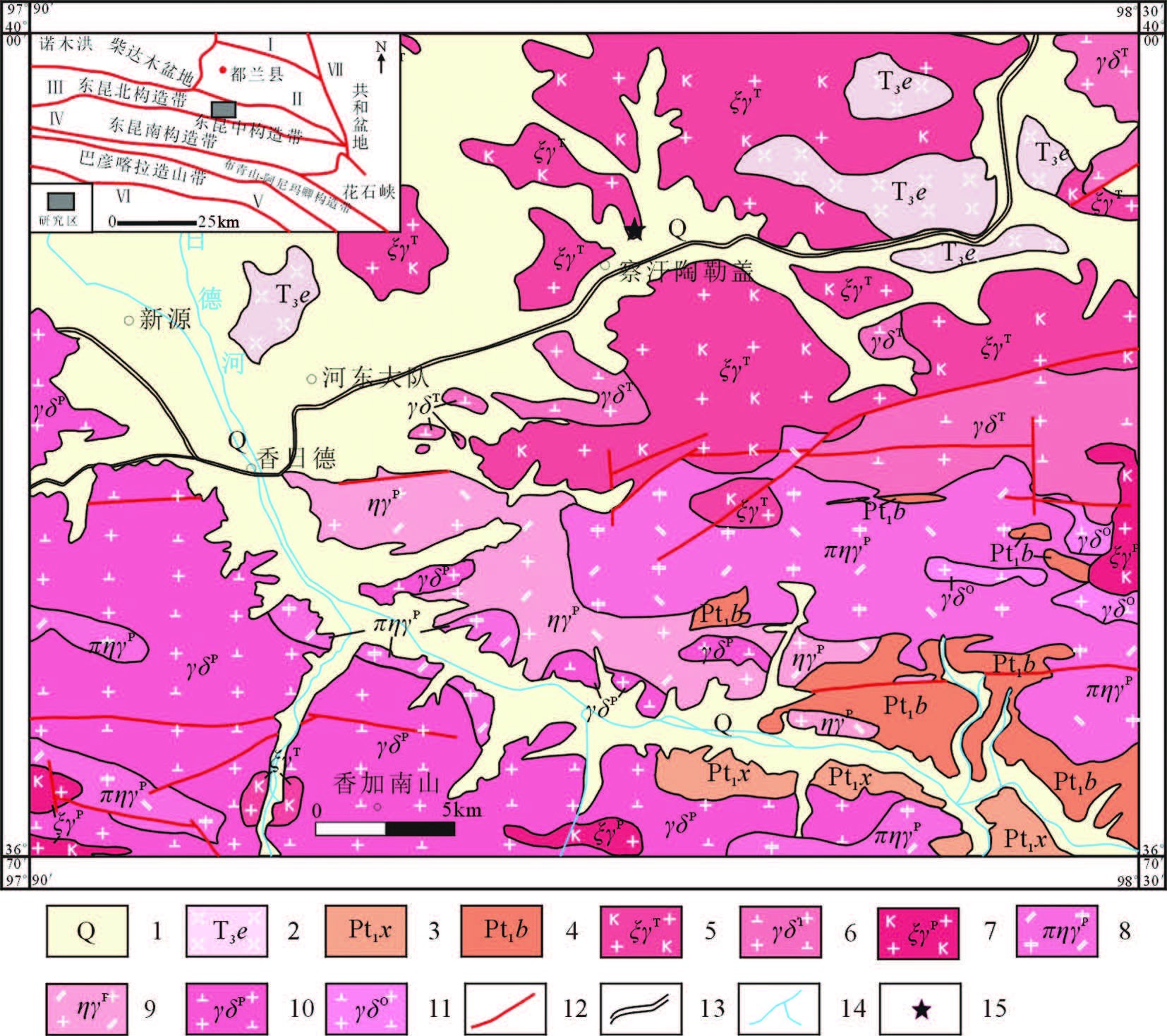
 下载:
下载:
